Testing the Uniformity of Surface Resistance on Large-Format Transparent Heating Glass
Abstract
:1. Introduction
2. Methods for Measuring the Surface Resistance of Thin Conductive Films
2.1. Principle of Surface Resistance Measurement by Contact Method
- two-point method—problem with accuracy and repeatability due to lack of compensation at the thin film-electrode interface. Low-cost implementation because a simple ohmmeter can be used as the measuring instrument—here, the resistance between the two electrodes can be measured,
- four-point method [26]—accurate method-measuring instruments are specialised Figure 5—here results are often converted to . This method is not new [27,28], but is still widely used in many fields. For example, in geophysics, to measure the shear strength of peat soil [29] or construction [30]. The exciting results of using this method to measure the in situ change in electrical resistivity during plastic deformation to characterise the deformation of metals were shown in [31].
2.2. Limitations of the Contact Method
2.3. Mechanism of Operation of the Eddy Current Non-Contact Method
3. Experimental Determination of the Surface Resistance of Coated Glass
3.1. M-3 Instrument Tests
3.2. Surface Resistance Measurements of Samples
3.3. Hardening of Heated Glass
4. Results and Discussion
4.1. The Coated Heater Concept
4.2. Verification of Uniformity of Temperature Distribution by Thermography
5. Conclusions
Author Contributions
Funding
Informed Consent Statement
Conflicts of Interest
References
- Shelby, J.E. Introduction to Glass Science and Technology; Royal Society of Chemistry: London, UK, 2020. [Google Scholar]
- Recast, E. Directive 2010/31/EU of the European Parliament and of the Council of 19 May 2010 on the energy performance of buildings (recast). Off. J. Eur. Union 2010, 18, 2010. [Google Scholar]
- Karasu, B.; Bereket, O.; Bİryan, E.; SanoğLu, D. The latest developments in glass science and technology. El-Cezeri 2017, 4, 209–233. [Google Scholar] [CrossRef]
- Dalapati, G.K.; Kushwaha, A.K.; Sharma, M.; Suresh, V.; Shannigrahi, S.; Zhuk, S.; Masudy-Panah, S. Transparent heat regulating (THR) materials and coatings for energy saving window applications: Impact of materials design, micro-structural, and interface quality on the THR performance. Prog. Mater. Sci. 2018, 95, 42–131. [Google Scholar] [CrossRef]
- Gupta, R.; Rao, K.D.M.; Kiruthika, S.; Kulkarni, G.U. Visibly transparent heaters. ACS Appl. Mater. Interfaces 2016, 8, 12559–12575. [Google Scholar] [CrossRef]
- Nourozi, B.; Ploskić, A.; Chen, Y.; Chiu, J.N.W.; Wang, Q. Heat transfer model for energy-active windows—An evaluation of efficient reuse of waste heat in buildings. Renew. Energy 2020, 162, 2318–2329. [Google Scholar] [CrossRef]
- Nourozi, B.; Ploskic, A.; Chen, Y.; Chiu, J.N.; Wang, Q. Integrated Energy Active Windows with Low-Temperature Heating Systems in Cold Climates. In Proceedings of the The 16th Conference of the International Society of Indoor Air Quality & Climate, Online, 1 November 2020; pp. 1054–1059. [Google Scholar]
- Durán, A.; Parker, J.M. Welcome to the Glass Age. Glass Technol. Eur. J. Glass Sci. Technol. Part A 2022, 63, 33. [Google Scholar]
- Casini, M. Active dynamic windows for buildings: A review. Renew. Energy 2018, 119, 923–934. [Google Scholar] [CrossRef]
- Zribi, A.; Barthès, M.; Bégot, S.; Lanzetta, F.; Rauch, J.Y.; Moutarlier, V. Design, fabrication and characterization of thin film resistances for heat flux sensing application. Sensors Actuators A Phys. 2016, 245, 26–39. [Google Scholar] [CrossRef]
- Zhang, H.; Miao, Z.; Shen, W. Development of polymer-dispersed liquid crystals: From mode innovation to applications. Compos. Part A Appl. Sci. Manuf. 2022, 163, 107234. [Google Scholar] [CrossRef]
- Castillo, M.S.; Liu, X.; Abd-AlHamid, F.; Connelly, K.; Wu, Y. Intelligent windows for electricity generation: A technologies review. Build. Simul. 2022, 15, 1747–1773. [Google Scholar] [CrossRef]
- Sun, Y.; Liu, D.; Flor, J.F.; Shank, K.; Baig, H.; Wilson, R.; Liu, H.; Sundaram, S.; Mallick, T.K.; Wu, Y. Analysis of the daylight performance of window integrated photovoltaics systems. Renew. Energy 2020, 145, 153–163. [Google Scholar] [CrossRef]
- Dong, L.; Zhu, G.S.; Xu, H.R.; Jiang, X.P.; Zhang, X.Y.; Zhao, Y.Y.; Yan, D.L.; Yuan, L.; Yu, A.B. Preparation of indium tin oxide (ITO) thin film with (400) preferred orientation by sol-gel spin coating method. J. Mater. Sci. Mater. Electron. 2019, 30, 8047–8054. [Google Scholar] [CrossRef]
- Lisnic, P.; Hrostea, L.; Leontie, L.; Girtan, M. Fluorine-doped SnO2 thin films in solar cell applications. Morphological, optical and electrical properties. Arch. Metall. Mater. 2023, 68, 483–490. [Google Scholar]
- Sharmin, A.; Tabassum, S.; Bashar, M.S.; Mahmood, Z.H. Depositions and characterization of sol–gel processed Al-doped ZnO (AZO) as transparent conducting oxide (TCO) for solar cell application. J. Theor. Appl. Phys. 2019, 13, 123–132. [Google Scholar] [CrossRef]
- Wu, Y.; Zhao, X.; Shang, Y.; Chang, S.; Dai, L.; Cao, A. Application-driven carbon nanotube functional materials. ACS Nano 2021, 15, 7946–7974. [Google Scholar] [CrossRef] [PubMed]
- Mora, A.; Verma, P.; Kumar, S. Electrical conductivity of CNT/polymer composites: 3D printing, measurements and modeling. Compos. Part B Eng. 2020, 183, 107600. [Google Scholar] [CrossRef]
- Wang, P.; Jian, M.; Wu, M.; Zhang, C.; Zhou, C.; Ling, X.; Zhang, J.; Yang, L. Highly sandwich-structured silver nanowire hybrid transparent conductive films for flexible transparent heater applications. Compos. Part A Appl. Sci. Manuf. 2022, 159, 106998. [Google Scholar] [CrossRef]
- Kim, Y.I.; An, S.; Kim, M.W.; Jo, H.S.; Kim, T.G.; Swihart, M.T.; Yarin, A.L.; Yoon, S.S. Highly transparent, conducting, body-attachable metallized fibers as a flexible and stretchable film. J. Alloy. Compd. 2019, 790, 1127–1136. [Google Scholar] [CrossRef]
- Lagrange, M.; Sannicolo, T.; Munoz-Rojas, D.; Lohan, B.G.; Khan, A.; Anikin, M.; Jiménez, C.; Bruckert, F.; Bréchet, Y.; Bellet, D. Understanding the mechanisms leading to failure in metallic nanowire-based transparent heaters, and solution for stability enhancement. Nanotechnology 2016, 28, 55709. [Google Scholar] [CrossRef] [PubMed]
- Papanastasiou, D.T.; Schultheiss, A.; Muñoz-Rojas, D.; Celle, C.; Carella, A.; Simonato, J.P.; Bellet, D. Transparent heaters: A review. Adv. Funct. Mater. 2020, 30, 1910225. [Google Scholar] [CrossRef]
- Gordon, R.G. Criteria for choosing transparent conductors. MRS Bull. 2000, 25, 52–57. [Google Scholar] [CrossRef]
- Oliveira, F.S.; Cipriano, R.B.; da Silva, F.T.; Romão, E.C.; Santos, C.A.M.D. Simple analytical method for determining electrical resistivity and sheet resistance using the van der Pauw procedure. Sci. Rep. 2020, 10, 16379. [Google Scholar] [CrossRef] [PubMed]
- Naftaly, M.; Das, S.; Gallop, J.; Pan, K.; Alkhalil, F.; Kariyapperuma, D.; Constant, S.; Ramsdale, C.; Hao, L. Sheet resistance measurements of conductive thin films: A comparison of techniques. Electronics 2021, 10, 960. [Google Scholar] [CrossRef]
- Miccoli, I.; Edler, F.; Pfnür, H.; Tegenkamp, C. The 100th anniversary of the four-point probe technique: The role of probe geometries in isotropic and anisotropic systems. J. Phys. Condens. Matter 2015, 27, 223201. [Google Scholar] [CrossRef]
- Smits, F.M. Measurement of sheet resistivities with the four-point probe. Bell Syst. Tech. J. 1958, 37, 711–718. [Google Scholar] [CrossRef]
- Shi, J.; Sun, Y. New method of calculating the correction factors for the measurement of sheet resistivity of a square sample with a square four-point probe. Rev. Sci. Instrum. 1997, 68, 1814–1817. [Google Scholar] [CrossRef]
- Afre, R.A.; Sharma, N.; Sharon, M.; Sharon, M. Transparent conducting oxide films for various applications: A review. Rev. Adv. Mater. Sci. 2018, 53, 79–89. [Google Scholar] [CrossRef]
- Robles, K.P.V.; Yee, J.J.; Kee, S.H. Effect of the Geometrical Constraints to the Wenner Four-Point Electrical Resistivity Test of Reinforced Concrete Slabs. Sensors 2021, 21, 4622. [Google Scholar] [CrossRef]
- Saberi, S.; Stockinger, M.; Stoeckl, C.; Buchmayr, B.; Weiss, H.; Afsharnia, R.; Hartl, K. A new development of four-point method to measure the electrical resistivity in situ during plastic deformation. Measurement 2021, 180, 109547. [Google Scholar] [CrossRef]
- Yang, W.; Sun, Q.; Lei, Q.; Zhu, W.; Li, Y.; Wei, J.; Li, M. Formation of a highly conductive thick film by low-temperature sintering of silver paste containing a Bi2O3-B2O3-ZnO glass frit. J. Mater. Process. Technol. 2019, 267, 61–67. [Google Scholar] [CrossRef]
- Frankowski, P.K. Corrosion detection and measurement using eddy current method. In Proceedings of the 2018 International Interdisciplinary PhD Workshop (IIPhDW), Gliwice, Poland, 9–12 May 2018; pp. 398–400. [Google Scholar] [CrossRef]
- Chen, W.; Wu, D. Resistance-frequency eddy current method for electrical conductivity measurement. Measurement 2023, 209, 112501. [Google Scholar] [CrossRef]
- Trofimov, A.A.; Watkins, T.R.; Muth, T.R.; Cola, G.M.; Wang, H. Infrared thermometry in high temperature materials processing: Influence of liquid water and steam. Quant. InfraRed Thermogr. J. 2023, 20, 123–141. [Google Scholar] [CrossRef]
- Kałuża, M.; Hatzopoulos, A. Application of extension rings in thermography for electronic circuits imaging. Quant. InfraRed Thermogr. J. 2022, 1–19. [Google Scholar] [CrossRef]
- Minkina, W. Theoretical basics of radiant heat transfer—Practical examples of calculation for the infrared (IR) used in infrared thermography measurements. Quant. InfraRed Thermogr. J. 2021, 18, 269–282. [Google Scholar] [CrossRef]
- Yoon, S.; Park, J.; Cho, Y. An experimental study on the evaluation of temperature uniformity on the surface of a blackbody using infrared cameras. Quant. InfraRed Thermogr. J. 2022, 19, 172–186. [Google Scholar] [CrossRef]



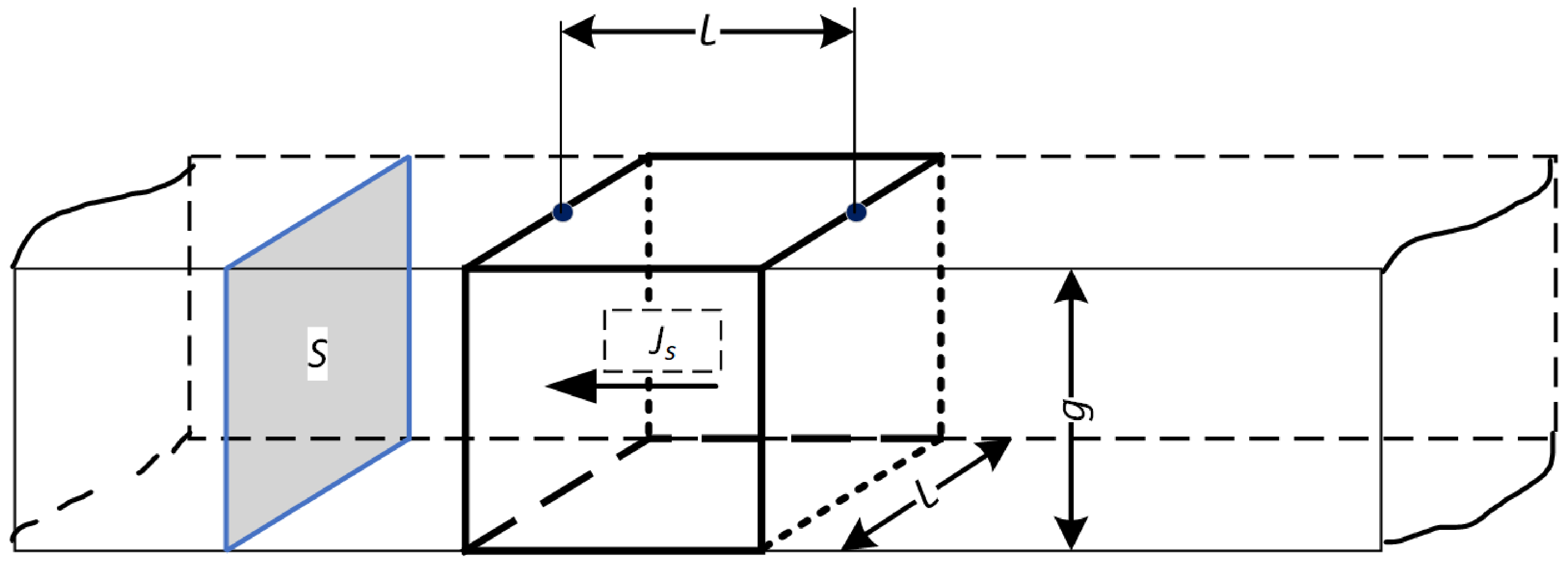
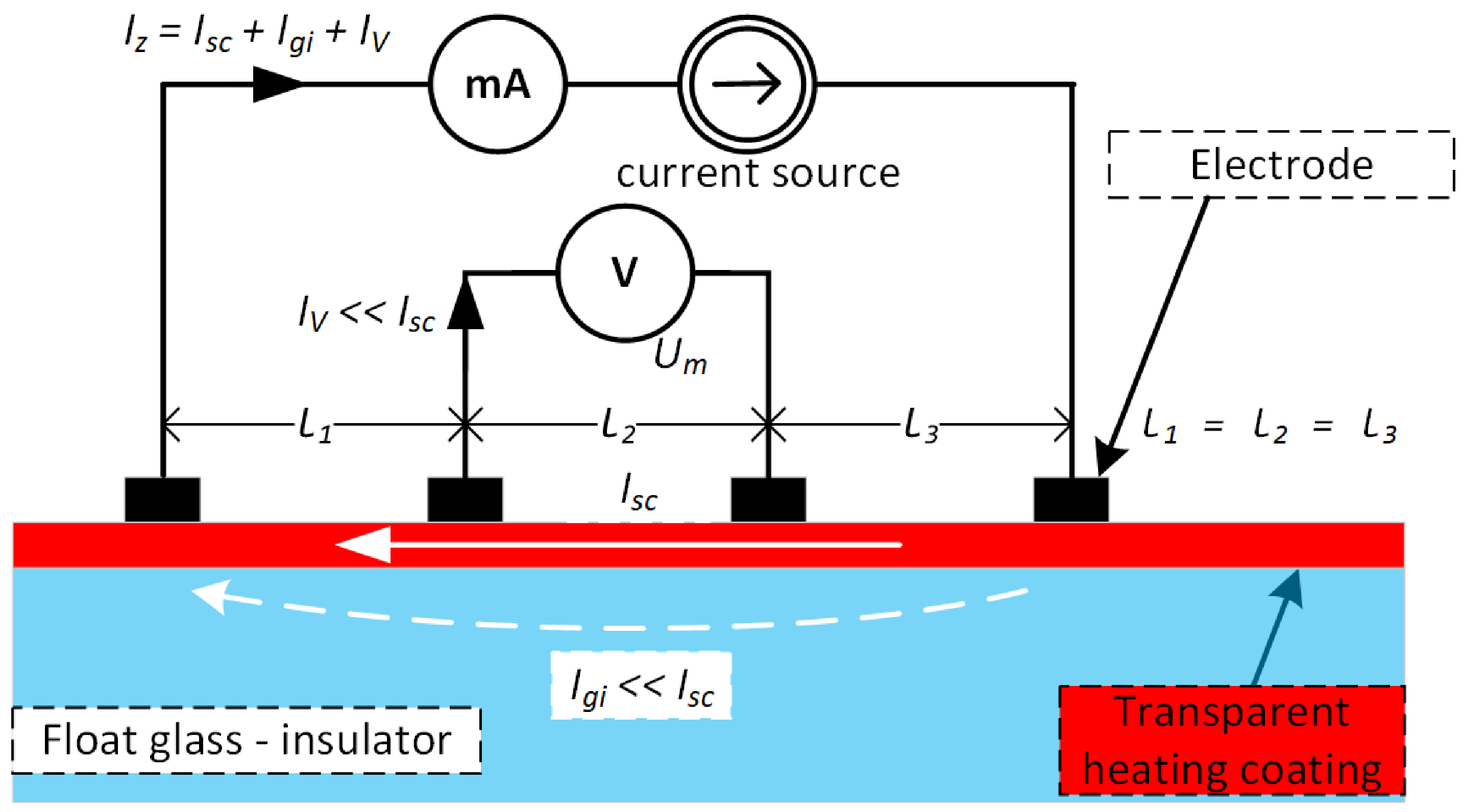

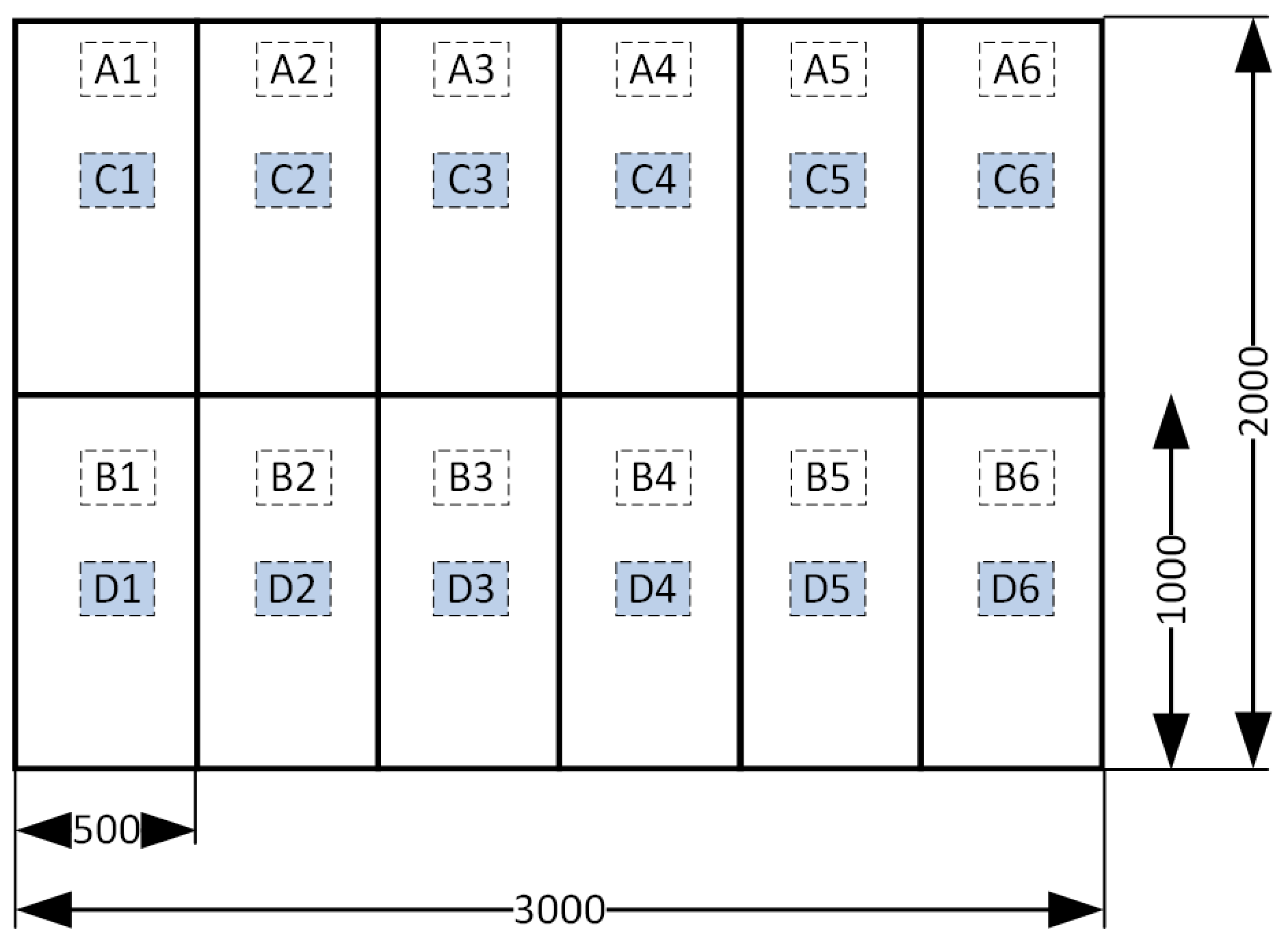
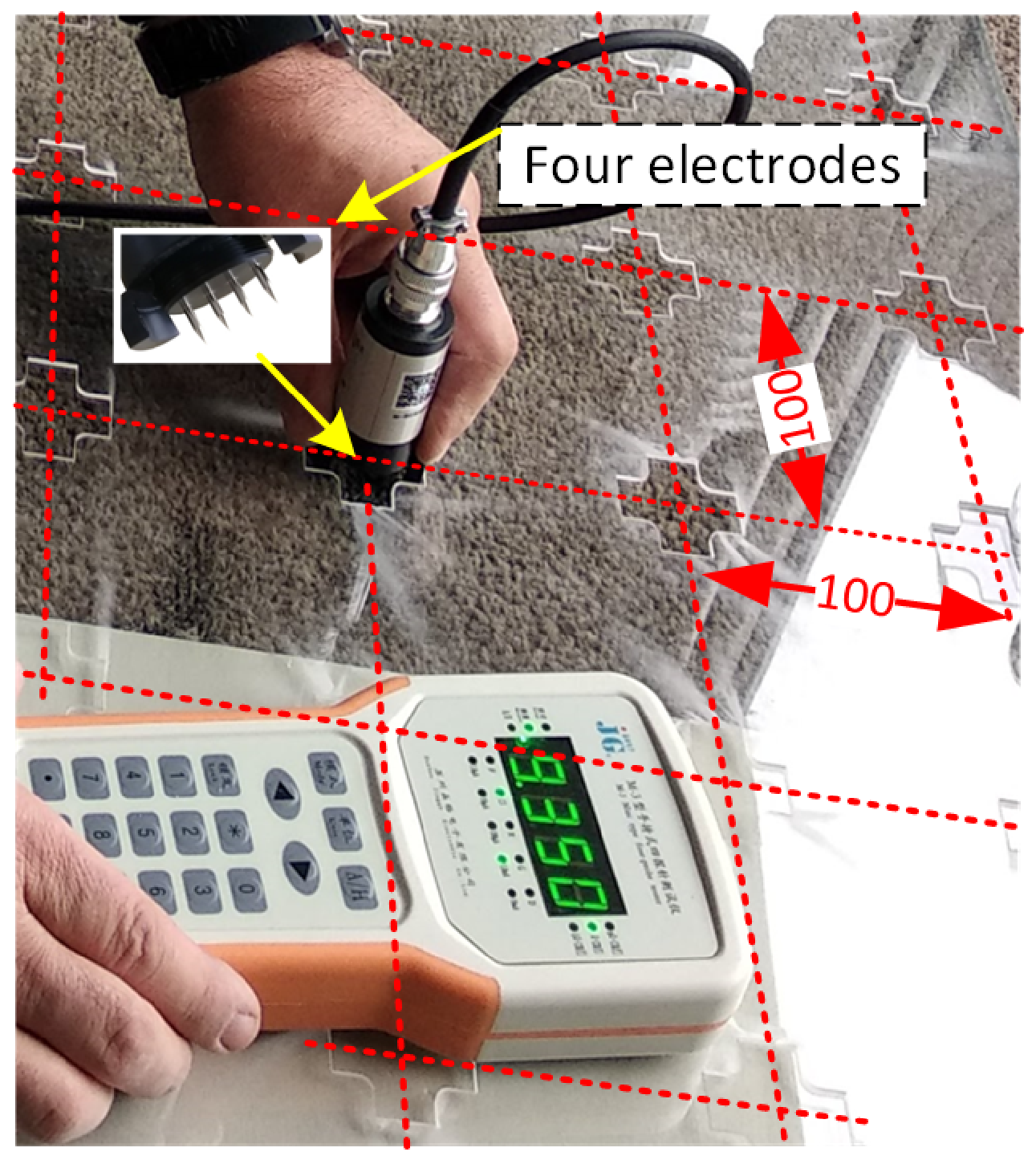

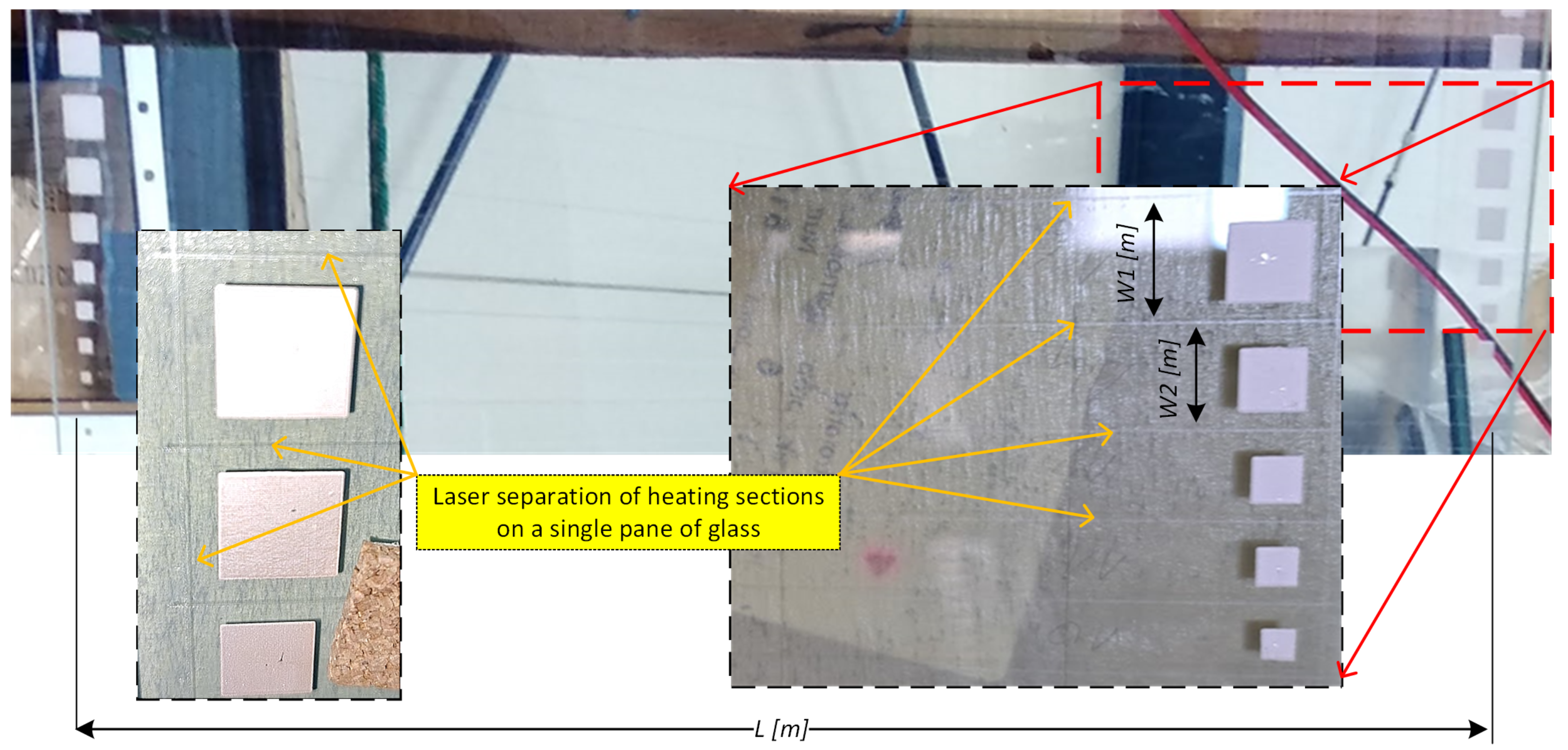

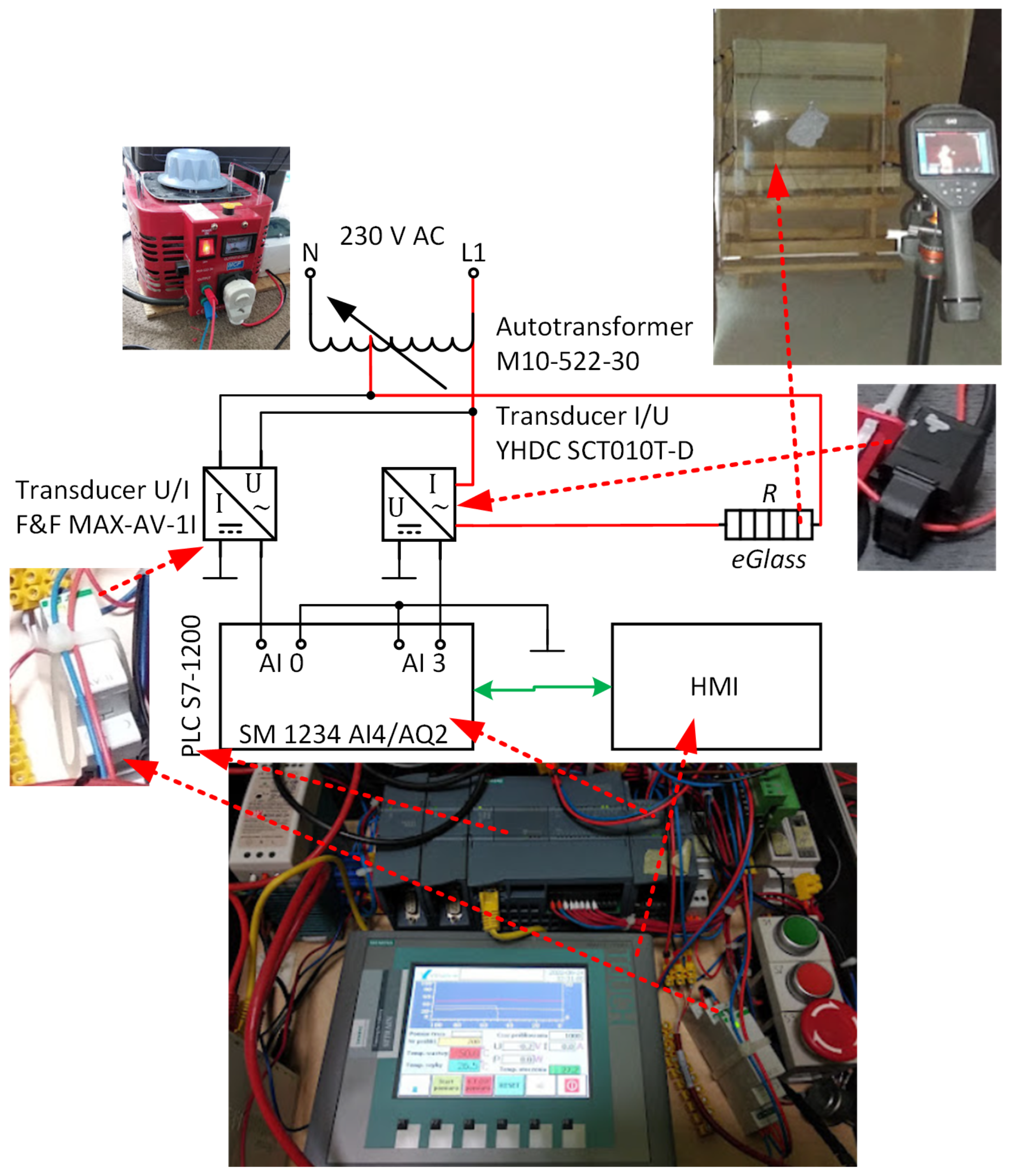
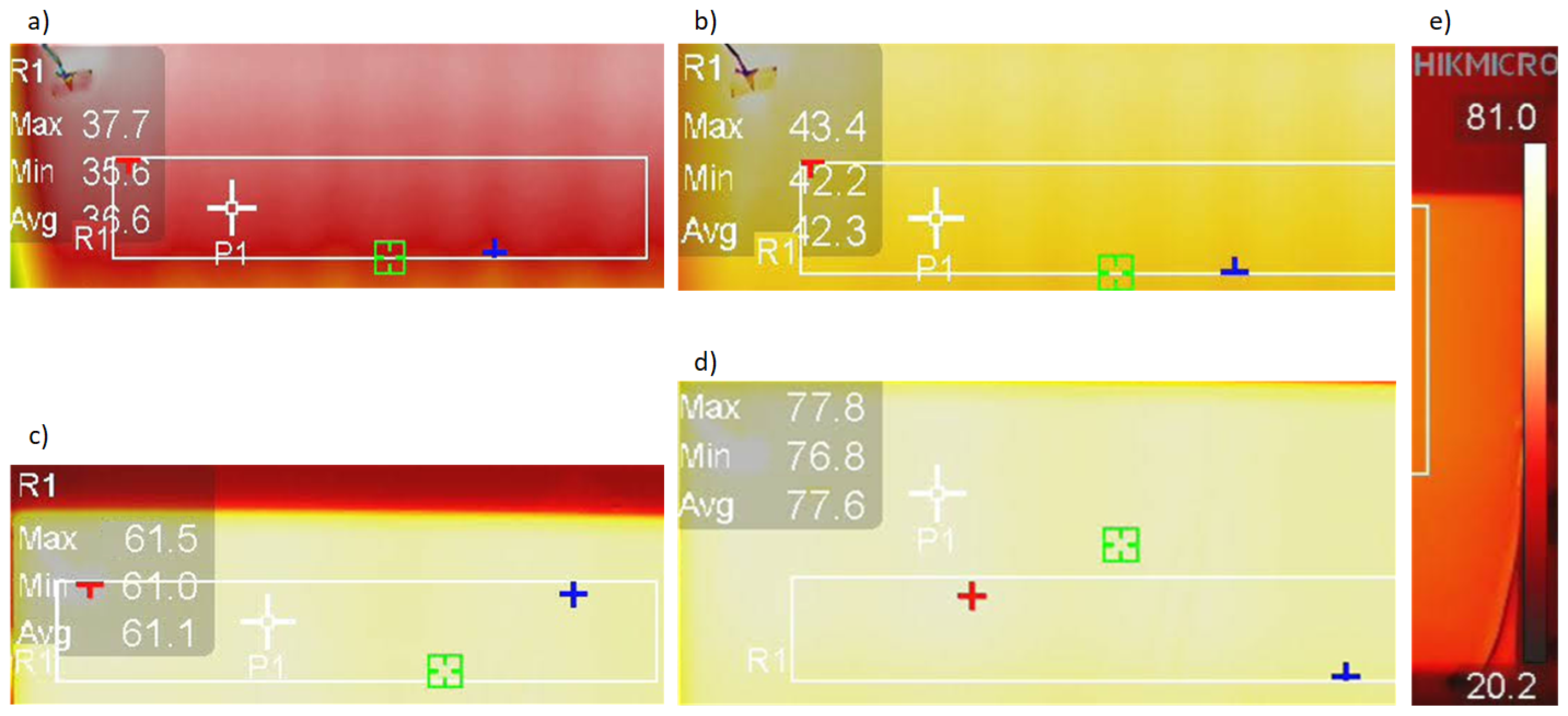
| Instrument | Suzhou Jingge Electronics M-3 | SURAGUS EddyCus TF Portable 1010 |
|---|---|---|
| Measurement head | ST2258B-F01 thin film square resistance linear four-point probe | integrated |
| Measurement technology | 4-point probe | Eddy current sensor |
| Measurement mode | contact | Realtime at constant distance or contact |
| Measurement spot | Straight line 4 mm | Diameter 40 mm |
| Sheet resistance range | 2 22 | 0.001 100 |
| Accuracy | ±1%FSB ± 2LSB (Full Scale Range, Least Significant Bit) | 0.001 50 : <3% 50 100 : <5% |
| Measurement Point No. | Position | Surface Resistance [] | Average | Standard Deviation | |||
|---|---|---|---|---|---|---|---|
| [mm] | Day 1 | Day 2 | Day 3 | Day 4 | [] | ||
| 1 | 0 | 9.47 | 9.63 | 9.53 | 9.35 | 9.50 | 0.14 |
| 2 | 80 | 9.60 | 9.53 | 9.74 | 9.33 | 9.55 | 0.20 |
| 3 | 160 | 9.30 | 9.65 | 9.28 | 9.74 | 9.49 | 0.29 |
| 4 | 240 | 9.89 | 9.44 | 9.54 | 9.69 | 9.64 | 0.24 |
| ine 5 | 320 | 9.58 | 9.46 | 9.30 | 9.77 | 9.53 | 0.24 |
| 6 | 400 | 9.69 | 9.41 | 9.79 | 9.46 | 9.59 | 0.22 |
| Temperature (C) | Time (s) | Sample No |
|---|---|---|
| 670 | 320 | C1, C6, D1 |
| 675 | 290 | A2, A3, A5 |
| 675 | 320 | B2, B3, B4, C2, C4, C5 |
| 675 | 380 | D2, D4, D5 |
| 680 | 320 | A6, B5, D6 |
| Head | Head Dir “|” () | Head | Head Dir “-” () | ||||||||
|---|---|---|---|---|---|---|---|---|---|---|---|
| Coords | 1 | 2 | 3 | 4 | 5 | Coords | 1 | 2 | 3 | 4 | 5 |
| 1 | 9.29 | 9.60 | 9.19 | 9.33 | 9.16 | 1 | 9.11 | 9.27 | 8.80 | 9.14 | 9.13 |
| 2 | 9.15 | 9.52 | 9.29 | 9.37 | 9.34 | 2 | 9.11 | 8.70 | 9.11 | 9.11 | 9.04 |
| 3 | 9.21 | 9.34 | 9.41 | 9.07 | 9.29 | 3 | 9.09 | 8.84 | 9.03 | 9.27 | 9.45 |
| 4 | 9.23 | 9.04 | 9.40 | 9.50 | 9.36 | 4 | 9.25 | 9.10 | 9.17 | 9.19 | 9.35 |
| 5 | 9.33 | 9.17 | 9.07 | 9.05 | 9.12 | 5 | 9.10 | 9.26 | 9.20 | 9.52 | 9.33 |
| 6 | 9.20 | 9.13 | 9.04 | 8.91 | 9.34 | 6 | 9.11 | 9.17 | 9.03 | 9.38 | 9.66 |
| 7 | 8.91 | 9.75 | 9.19 | 8.92 | 8.89 | 7 | 9.22 | 9.03 | 9.09 | 9.17 | 9.33 |
| 8 | 9.17 | 8.97 | 8.99 | 8.86 | 9.53 | 8 | 9.12 | 9.33 | 9.17 | 9.04 | 9.02 |
| 9 | 8.91 | 9.55 | 9.68 | 9.25 | 9.26 | 9 | 9.12 | 8.91 | 9.11 | 8.91 | 9.14 |
| 10 | 9.05 | 8.82 | 9.12 | 9.02 | 9.11 | 10 | 9.16 | 9.06 | 9.00 | 9.33 | 9.30 |
| Head Coords | “B2” Surface Resistance () before Hardening | Head Coords | “B2” Surface Resistance () after Hardening: 675 , 320 s | ||||||||
|---|---|---|---|---|---|---|---|---|---|---|---|
| 1 | 2 | 3 | 4 | 5 | 1 | 2 | 3 | 4 | 5 | ||
| 1 | 9.38 | 9.72 | 9.03 | 9.10 | 9.08 | 1 | 9.40 | 9.49 | 9.35 | 9.20 | 9.37 |
| 2 | 9.38 | 9.56 | 9.34 | 9.37 | 9.14 | 2 | 9.34 | 9.46 | 9.29 | 9.26 | 9.47 |
| 3 | 9.02 | 9.53 | 9.43 | 9.50 | 9.42 | 3 | 9.49 | 9.40 | 9.41 | 9.30 | 9.23 |
| 4 | 9.35 | 9.51 | 9.56 | 9.36 | 9.33 | 4 | 9.35 | 9.62 | 9.57 | 9.48 | 9.13 |
| 5 | 9.05 | 9.33 | 9.23 | 9.30 | 9.38 | 5 | 9.59 | 9.33 | 9.26 | 9.85 | 9.56 |
| 6 | 9.30 | 9.17 | 9.27 | 9.35 | 9.22 | 6 | 9.42 | 9.49 | 9.14 | 9.66 | 9.54 |
| 7 | 9.33 | 9.41 | 9.51 | 9.06 | 9.34 | 7 | 9.46 | 9.68 | 9.76 | 9.58 | 9.51 |
| 8 | 9.19 | 9.50 | 9.40 | 9.29 | 9.35 | 8 | 9.64 | 9.55 | 9.78 | 9.36 | 9.24 |
| 9 | 9.17 | 9.45 | 9.23 | 9.16 | 9.35 | 9 | 9.37 | 9.54 | 9.49 | 9.49 | 9.42 |
| 10 | 9.27 | 9.03 | 9.01 | 9.55 | 9.33 | 10 | 9.42 | 9.35 | 9.21 | 9.31 | 9.11 |
| Head Coords | “B5” Surface Resistance () before Hardening | Head Coords | “B5” Surface Resistance () after Hardening: 680 , 320 s | ||||||||
|---|---|---|---|---|---|---|---|---|---|---|---|
| 1 | 2 | 3 | 4 | 5 | 1 | 2 | 3 | 4 | 5 | ||
| 1 | 9.40 | 9.29 | 9.35 | 9.60 | 9.51 | 1 | 9.30 | 9.13 | 9.40 | 9.66 | 9.27 |
| 2 | 9.29 | 9.32 | 9.29 | 9.82 | 9.87 | 2 | 9.50 | 9.59 | 9.40 | 9.59 | 9.72 |
| 3 | 9.52 | 9.22 | 9.33 | 9.40 | 9.40 | 3 | 9.29 | 9.30 | 9.34 | 9.30 | 12.03 |
| 4 | 9.30 | 9.53 | 9.39 | 9.62 | 9.35 | 4 | 9.57 | 8.91 | 9.30 | 9.79 | 9.23 |
| 5 | 9.42 | 9.64 | 9.46 | 9.79 | 9.74 | 5 | 9.40 | 9.19 | 9.32 | 9.41 | 9.40 |
| 6 | 9.62 | 9.33 | 9.35 | 9.55 | 9.51 | 6 | 9.44 | 9.65 | 9.14 | 9.29 | 8.68 |
| 7 | 9.38 | 9.56 | 9.40 | 9.65 | 9.29 | 7 | 9.48 | 9.24 | 10.36 | 9.44 | 11.33 |
| 8 | 9.23 | 9.21 | 9.56 | 9.47 | 9.55 | 8 | 9.25 | 9.15 | 10.26 | 10.75 | 9.19 |
| 9 | 9.47 | 9.41 | 9.56 | 9.45 | 9.58 | 9 | 10.16 | 9.15 | 10.59 | 10.04 | 9.78 |
| 10 | 9.40 | 9.39 | 9.27 | 9.42 | 9.52 | 10 | 9.15 | 9.30 | 9.17 | 9.29 | 9.46 |
| Parameter | Value |
|---|---|
| Thermal resolution | 480 × 360 (172,800 pixels) |
| Noise Equivalent Temperature Difference (NETD) | <35 mK (@ 25 C, F# = 1.0) |
| Temperature measurement range | −20 C to 650 C |
| Accuracy | ±2 C/3.6 F, |
| Spectral Range | 8–14 µm |
| Instantaneous Field of View (IFOV) | 0.68 mrad |
Disclaimer/Publisher’s Note: The statements, opinions and data contained in all publications are solely those of the individual author(s) and contributor(s) and not of MDPI and/or the editor(s). MDPI and/or the editor(s) disclaim responsibility for any injury to people or property resulting from any ideas, methods, instructions or products referred to in the content. |
© 2023 by the authors. Licensee MDPI, Basel, Switzerland. This article is an open access article distributed under the terms and conditions of the Creative Commons Attribution (CC BY) license (https://creativecommons.org/licenses/by/4.0/).
Share and Cite
Flaga, S.; Dominik, I.; Szybiński, M. Testing the Uniformity of Surface Resistance on Large-Format Transparent Heating Glass. Sensors 2023, 23, 8738. https://doi.org/10.3390/s23218738
Flaga S, Dominik I, Szybiński M. Testing the Uniformity of Surface Resistance on Large-Format Transparent Heating Glass. Sensors. 2023; 23(21):8738. https://doi.org/10.3390/s23218738
Chicago/Turabian StyleFlaga, Stanisław, Ireneusz Dominik, and Marek Szybiński. 2023. "Testing the Uniformity of Surface Resistance on Large-Format Transparent Heating Glass" Sensors 23, no. 21: 8738. https://doi.org/10.3390/s23218738





